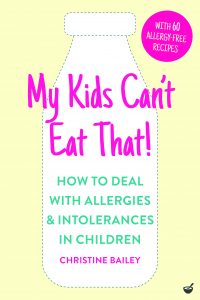It’s World Allergy Day on July 3 and with the latest surveys estimating that true food allergies affect up to eight per cent of children, and 40 per cent of children and adults now suffer from food sensitivities or intolerances, Sky and BBC nutritional expert Christine Bailey, reveals how she helped her son beat a rare autoimmune condition through his diet and how parents can take a pro-active approach to coping with food allergies in their child…
As a coeliac myself, and with three sons who between them cannot eat a range of foods, I have learnt how to adapt our family life and eating patterns without compromising our health or enjoyment of delicious foods. My son Isaac is a twin and was a healthy thriving baby. At the age of two however he was rushed into hospital due the sudden appearance of painful blisters over his body. After discussion and investigations with the consultants, Isaac was diagnosed with a rare autoimmune condition Linear IgA bullous disease. Following investigations and referral to Great Ormond Street Hospital the outlook was bleak – steroidal medications to dampen the inflammation and lower the flare ups – not something I was willing to consider.
As I am coeliac and I knew Isaac carried the coeliac genes (coeliac disease is also an autoimmune condition and often associated with other autoimmune conditions) I decided to do some investigations. I was aware of some research studies that demonstrated that symptoms improved on the removal of gluten so to me it was an easy decision. With the support of my GP I removed both gluten and dairy from his diet (dairy is a common cross-reactive food with gluten) and within two weeks his blisters had disappeared and within a month there was no sign of the condition at all. Further investigations and private tests much later indicated Isaac also had gut infections which I addressed taking a functional medicine approach and long term by supporting the gut microbiome with certain key foods and supplements. Isaac, now 14 years, has been symptom free ever since. He still follows a gluten free and mainly dairy free diet and feels much better for it.
Allergies and Intolerances Explained
Allergies occur when the immune system misreads a harmless substance, such as a food, as pathogenic and launches an antibody attack to destroy it. Sometimes the immune system gets really confused and launches an attack against its own cells. When this happens, we are said to have an autoimmune reaction (coeliac disease is an autoimmune condition as it causes the body to attack the delicate lining of the gut).
When doctors refer to a food allergy, most of the time they are referring to an IgE-mediated food allergy, which you may also hear called a “true” or “classic” food allergy. These types of reactions are most common in children rather than adults. Symptoms tend to be immediate, typically occurring within two hours of eating and are normally very obvious. It can be triggered by consumption of only a tiny amount of food. It may result in a range of symptoms, including itchy rashes, sneezing and in some cases anaphylaxis. While any food can trigger such a reaction the most common are cow’s milk, eggs, fish and shellfish, peanuts, soybeans (and related products), tree nuts (e.g. almonds, pistachios, hazelnuts, walnuts, cashews, pecans, Brazils, macadamia nuts) and wheat.
It is estimated that up to 45 per cent of people may suffer with food sensitivities, but they are often harder to identify. This is because reactions tend to be delayed, in some cases taking between one and two days to appear. Symptoms are varied, and may affect many different body systems, but they are not normally life-threatening.
A child develops a food intolerance when something in a food irritates his or her digestive system or when he or she is unable to properly digest – or break down – the food. As these reactions involve the digestive system many of the symptoms are linked to gut health. Lactose intolerance is probably the most common type but others such as fructose intolerance and intolerance to sulphites, MSG are other examples.
Eating Out
European and UK law require eateries across all European countries to let customers know which foods on their menu contain any of the 14 primary allergens. However, there is no regulation as to how this information might be conveyed, which can make eating out incredibly stressful. Here’s some advice which might help:
Choosing your venue: Some restaurants – and cuisines – may be better suited than others for catering for people with allergies. For example, restaurants that cook everything to order from scratch rather than buying in prepared sauces and other menu items are usually good choices.
Plan Ahead: Book a table and explain your child’s allergies when you book. Make sure they note it and you feel comfortable they understand the implications. Ask about cross contamination – how do they prepare allergy free dishes and make sure it is not contaminated during preparation and cooking. Consider taking surface wipes with you. You can minimize the risks of cross-contamination in restaurants and cafés by wiping down tables (and high chairs or baby seats) before you sit down. This is important if your child has a risk of anaphylaxis.
Ordering: When you arrive at the restaurant, tell the front-of-house staff that your child has allergies and state very clearly what they are. Repeat the information to waiting staff when they bring the menus, and again when they take the order.
When you order, ask questions if you need to double check ingredients. For example, ask whether sauces are thickened with wheat flour, or whether fried foods are dusted in flour before frying. If your child is dairy free, ask whether butter is used as an emulsifier in sauces or to coat vegetables before they come to the table. Have eggs been used to bind burgers or as a glaze on meats or breads?
Travelling
Check your Health Insurance
The EHIC, or European Health Insurance Card, is free and gets free or discounted medical care in all 28 EU countries so check yours is up to date. Check your health insurance to ensure allergies are covered.
Carry a medical note
If you or your child is diagnosed with coeliac disease or needs a gluten-free diet, it can be helpful to carry a letter from your medical practitioner, especially is they have to take any prescription medication. Always carry your child’s allergy medicine and auto-injectors (if needed) with you in your hand luggage.
Watch for Cross Contamination
Buffets are a minefield when it comes to cross-contamination. Many hotels and restaurants if given notice will be able to provide something for you. Always ask about what precautions they take to prevent cross contamination when preparing food.
Translation Cards
If you’re traveling overseas, dietary cards and translation cards are a good idea. These can help communicate to your restaurant server, in their native language, your specific dietary requirements. Translation cards can also address multiple food allergies and intolerances. Allergyaction.org and Allerglobal.com offer free, printable translations cards.
PARTIES AND PLAY DATE
If your child is invited to a party, let the host know when you accept the invitation about his or her allergies and tell them you’ll drop off a special party tea when you arrive. Ask what sorts of things their party tea will serve up and offer to bring similar allergy-free food to take the pressure off the host.
If your child is staying overnight at a friend’s house, offer to provide plenty of provisions to cover breakfast, as well as other meals and snacks. Use a cool bag, if you need. Keep foods wrapped or sealed within the containers and label them clearly. Remember to pack drinks, if relevant, too. Before you leave your child, make sure the host knows what to do if your child has a reaction and leave labelled medications just in case. Ask if he or she would like a list of culprit foods, and make sure you provide your mobile phone number. This is not only essential in case of emergency, but if the host is concerned about a certain product he or she is serving up, they can take a photo of the food label and send it to you to check yourself.

Written by award-winning Nutritionist and chef Christine Bailey, My Kids Can’t Eat That: How to deal with Allergies and Intolerances in Children is a no-nonsense guide containing 60 allergy-free recipes and is the result of over a decade of private practice with families suffering with allergies and intolerances – as well as personally managing allergies with her own three sons.RRP £14.99 Published by Watkins Publishing, out August 16.

